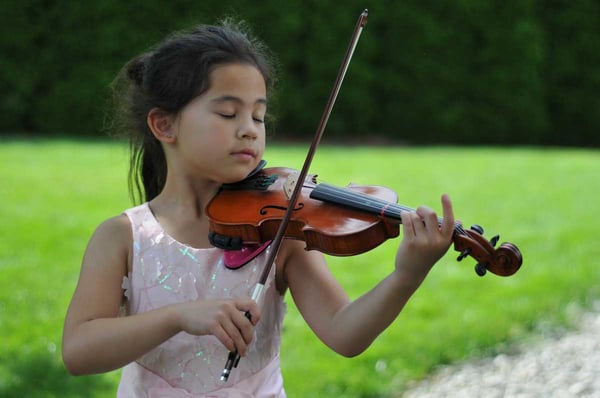
The children’s song “Head, Shoulders, Knees, and Toes” has been used over the last sixty years to teach young children anatomy and to get them moving as they point to each part. The tune is actually a good advertisement for how we, as violinists and violists, should make use of our bodies as we play—from the top of our heads down to the soles of our feet. However, movement sometimes is derailed because we have
chosen non-ergonomic equipment, especially in our choice of chinrests and shoulder pads.
[This article, by Lynne Denig was originally published in American String Teacher, Vol. 67, No. 1, © 2017 by American String Teachers Association. It has been formatted for our blog page with permission. Click to read the whole article!]
Let’s Start with a Sports Analogy
As people move, they become aware of what touches them and how clothing or shoes, for example, affect their range of movement. Ever since the advent of Spandex, dancers and athletes have many more options for clothing that allows them to move. And what dancer or athlete, for instance, doesn’t understand the value of a good-fitting pair of slippers or shoes?
As for the choice of athletic shoes, this is what the American Orthopaedic Foot and Ankle Society (AOFAS) has to say (2016):
Proper-fitting sports shoes can enhance performance and prevent injuries. Follow these fitting facts when purchasing a new pair of athletic shoes.
1. If possible, purchase athletic shoes from a specialty store. The staff will provide valuable input on the type of shoe needed for your sport as well as help with proper fitting. This may cost a premium in price but is worthwhile, particularly for shoes that are used often.
2. Try on athletic shoes after a workout or run and at the end of the day. Your feet will be at their largest.
3. Wear the same type of sock that you will wear for that sport.
4. When the shoe is on your foot, you should be able to freely wiggle all of your toes.
5. The shoes should be comfortable as soon as you try them on. There is no break-in period.
6. Walk or run a few steps in your shoes. They should be comfortable.
7. Always re-lace the shoes you are trying on. You should begin at the farthest eyelets and apply even pressure as you create a crisscross lacing pattern to the top of the shoe.
8. There should be a firm grip of the shoe to your heel. Your heel should not slip as you walk or run.
9. If you participate in a sport three or more times a week, you need a sport-specific shoe.
10. It can be hard to choose from the many different types of athletic shoes available. There are differences in design and variations in material and weight. These differences have been developed to protect the areas of the feet that encounter the most stress in a particular athletic activity.
As to equipment for violinists and violists, many of the same concerns are valid — the equipment we choose affects the way that we move. Non-ergonomic chinrests that ask us to hold one head position over time, as well as shoulder pads that limit left shoulder movement, keep us from playing with our full selves. In essence, they make us work harder to say what we want to say musically. At worst, non-ergonomic equipment causes pain, ruins our love of playing, and shortens our playing lives.
Stephen O'Dwyer, neuromuscular therapist, health educator, and bodywork instructor says the following about the consequences of chronic muscular contraction (2016):
If a muscle cannot return to its normal resting length, it then resides in a state of chronic contraction and numerous undesirable consequences can result…
1. A chronically contracted muscle can become ischemic (low blood flow). Imagine the white knuckles of a clenched fist. No blood flow there. An ischemic muscle is often a painful muscle.
2. A chronically contracted muscle can develop trigger points which refer pain (or numerous other possible sensations— thermal, tingling, numbness, aching) either radiating out from the muscle or felt in other parts of the body.
3. A chronically contracted muscle can distort the movement of the joint it crosses. For example, a chronically tight iliacus could reduce movement at the front of the hip.
4. A chronically contracted muscle can cause other compensations or distortions in the body. If a chronically tight iliacus, for example, reduces movement in one hip, then the other hip or the spine or other parts of the body will be called upon to compensate or to change their normal pattern of movement.
5. A chronically contracted muscle may be responsible for entrapment of nerves, another cause of pain.
While discomfort also can be due to congenital predispositions such as leg length differences or curvature of the spine, or due to untreated injuries away from the instrument, equipment can exacerbate preexisting problems or spawn muscular problems for the rare person who originally was problem free.
We might say that if the shoulder girdle (the head/neck/shoulder area) is held in constant contraction, pain is the likely result. The term radiculopathy (Spine-health 2016), covers pain and weakness in the arms and hands due to contracted head positions.
From what I have seen in students and in chinrest clients, it’s my belief that clenching in the shoulder girdle area is the number one cause of playing-related pain problems in violinists and violists—and that many problems can be remedied if the proper set up of shoulder pad and/or chinrest can be found.
Recommendations for Choosing a Chinrest and Shoulder Pad
If we were to adapt the AOFAS recommendations on choosing athletic shoes to recommendations for choosing a chinrest and/or shoulder pad, they might read as follows (with editorial comments in brackets):
Proper-fitting chinrests and shoulder pads can enhance performance and prevent injuries. Follow these equipment facts when purchasing a chinrest and/or shoulder pad:
1. If possible, purchase chinrests and shoulder pads from a specialty store. [Before shopping, search for stores online for “chinrest fitting” or “shoulder pad fitting”]. The staff will provide valuable input on the type of chinrest or shoulder pad needed for your unique physical makeup. [Yes, everyone needs something different because we are built differently one from another. Remember that chinrests and shoulder pads are a personal object just like shoes. If we do not wear the same shoes, why should we all use the same equipment?] You will move more freely when your equipment is ergonomic. [And your sound will open up. Paul Rolland (1976), movement pedagogue, said to me in a private lesson, “The quality of your movements determines the quality of your sound”]. This may cost a premium in price but is worthwhile, particularly because both our physical and emotional health depend on finding ergonomic equipment.
2. Try out chinrests and shoulder pads in the presence of another string player, preferably one who has a good eye for body mechanics. [This could be a string player who is an Alexander Technique specialist, a Body Mapping specialist, a Rolland String Pedagogy specialist, or a physical therapist, etc.].
3. Wear the same type of clothing that you will wear when practicing, and bring your concert garb to try out the equipment. You might need a different chinrest or shoulder pad or even a different shape of either depending on the clothing you wear when performing.
4. When placing the instrument in playing position [and there needs to be a good process of placing it (Frisch and Denig 2012)], you should have about the width of one finger between your jaw and the top of the chinrest. This space allows a little head tilt left or straight up in response to bow arm movements. If there is much more than a finger of space, the equipment’s height is too short. Figures 1 – 9 show common problems with ill-fitting equipment.
5. The chinrest and shoulder pad should be comfortable as soon as you try them on. There is no break-in period. [There is no “maybe I just need to get used to it,” or “I can ignore the discomfort,” or “my teacher/favorite player plays this way and I want to honor/look like him/her;” rather, does your equipment allow you to be fully you?]
6. Play a variety of music, including something with shifting and vibrato. The chinrest and shoulder pad should be comfortable and should not impede natural, human movement.
7. When trying out shoulder pads try different shapes, even from the same manufacturer. [I recommend something soft and yielding—even a folded chamois cloth or wash cloth, a cosmetic sponge or carpet sponge, etc., or one of the air-filled models of shoulder pads commercially available. Remember: rigid models breed rigid responses. For an image of how rigid shoulder pads affect the body, imagine an athlete running while using a walker. The walker keeps you upright, but your limbs will not swing easily, impeding movement].
8. The ergonomically-shaped top of the chinrest allows your head to nod slightly down into the top of the chinrest and to “catch” the violin or viola, lightly drawing the instrument back into your neck. When you drop your left hand, the instrument will droop but not fall because the tip of your chin can latch onto the chinrest ridge; a ridge that compliments the shape of the tip of your chin (Denig 2009). A good-fitting chinrest will make the instrument feel lighter in weight because the weight is born closer to the spine, the body’s support system, and not out along the collarbone and across the chest. The shoulder pad is not the sole supporter of the instrument; light, dynamic left hand support is key to balanced, dynamic technique. Sole support of the instrument by one part of the body all of the time causes fatigue, especially in that body part, and eventual pain and injury if ignored. Be aware that if the head/neck/shoulder area is not kept free to move from time to time, tensions in that area can radiate around the body.
9. If you don’t do much playing, all of this might not matter because the effects of heavy-duty playing might not present themselves. But if you love what you do no matter your “sport” (bluegrass, jazz, classical, etc.) and you spend time with it, you need to be fitted for ergonomic equipment.
10. It can be hard to choose from the many different types of chinrests and shoulder pads available. There are differences in design and variations in material and weight. These differences should have been developed to help you “juggle” the instrument lightly and effortlessly and not to hold the instrument with vice-like gripping between the head and left shoulder.
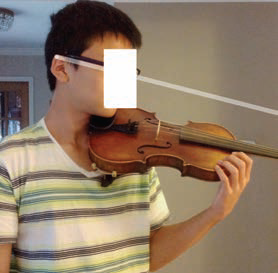
Fig. 1: When equipment is too short, the head tilts forward.
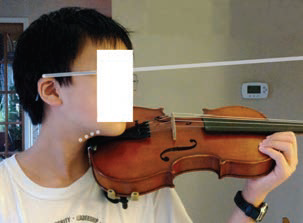
Fig. 2: If there is less than a finger of space between the top of the chinrest and the bottom of the jaw, then the equipment is too tall. When equipment is too tall, the head tilts back and the chin is up.
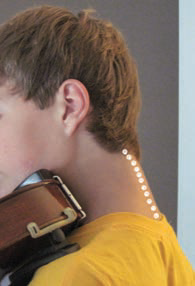
Fig. 3: Too-short equipment causes extra stretching in the back of the neck and gripping in the front of the neck. Often, the healthy curve at the back of the neck is lost. Th e player in fi g. 3 has a convex “C” at the back of his neck instead of the recommended gently concave “C.”
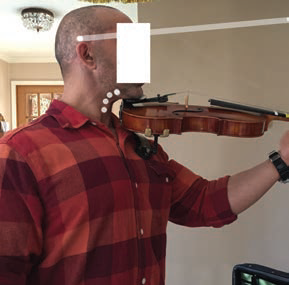
Fig. 4: A too-tall set up causes extra stretching in the front of the neck and gripping in the back of the neck. In fig. 4, notice the stretch of skin under this player’s neck and the light between his neck and the instrument. Also, because the head cannot release a little weight into the top of the chinrest, the instrument is slipping away from him.
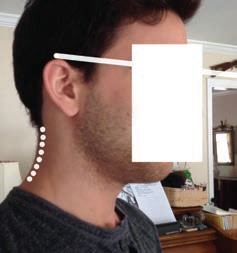
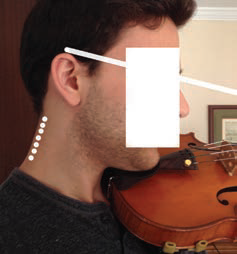
Figs. 5A and 5B: Equipment that is too low or too tall can pull the head out of its normal non-playing position. In figs. 5A and 5B, notice the healthy neck shape in the fi rst photo, and how that shape is changed when equipment is too low. All of these tendencies can be in order to avoid pressure on the jaw, to try to clamp the instrument between the jaw and left shoulder, and/or in order to clamp the instrument against the chest.
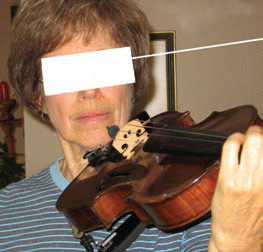
Fig. 6: A too-tall shoulder pad pushes up against the left corner of the jaw, causing the head to tilt right.
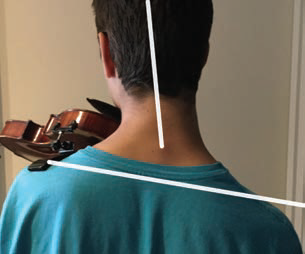
Fig. 7: Equipment that does not fi t the player also causes a raised left shoulder. Fig. 7 shows a classic example of the effects of equipment that does not suit the individual—a raised left shoulder and a neck that pulls left to clamp the instrument out along the shoulder and across the chest.
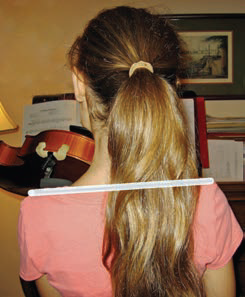
Fig. 8: When a shoulder pad is too high, sometimes the player will shove their left shoulder down to take up all the height of the shoulder pad. This is often seen in young players who are given too- tall shoulder pads when their physique does not warrant it.
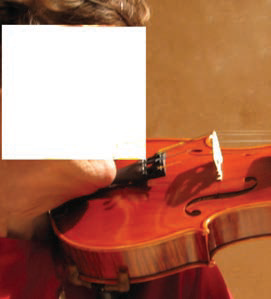 Fig. 9: In an effort to stabilize the instrument on the chest, often players will jut their chins out over the tailpiece creating “forward head,” one of the worst painproducing postures in playing. Fig. 9 shows a classic example of forward head. Note that the chin is more than halfway up the tailpiece. Also, the stretch of skin under the jaw is a sign of forward head. If the chinrest shape is correct for your jaw shape, you will be able to freely swivel your head left and right across the surface of the chinrest without the chinrest “biting” or pinching your jaw bone even when playing. Horrible bruises and wounds on the neck are common for players who use chinrests that are the incorrect shape for their jawline. You also should be able to freely swing your left arm left and right under the instrument without the shoulder pad stopping the movement. Your head should be able to tilt in any direction; equipment should not dictate head placement.
Fig. 9: In an effort to stabilize the instrument on the chest, often players will jut their chins out over the tailpiece creating “forward head,” one of the worst painproducing postures in playing. Fig. 9 shows a classic example of forward head. Note that the chin is more than halfway up the tailpiece. Also, the stretch of skin under the jaw is a sign of forward head. If the chinrest shape is correct for your jaw shape, you will be able to freely swivel your head left and right across the surface of the chinrest without the chinrest “biting” or pinching your jaw bone even when playing. Horrible bruises and wounds on the neck are common for players who use chinrests that are the incorrect shape for their jawline. You also should be able to freely swing your left arm left and right under the instrument without the shoulder pad stopping the movement. Your head should be able to tilt in any direction; equipment should not dictate head placement.
As with anything in life, balance helps us to reach our goals. Using equipment that helps us be physically balanced allows us to play using not just held or restricted parts, but with our full self—from our head to our shoulders and even down to our knees and toes.
Lynne Denig teaches violin and viola in Fairfax, Virginia, with degrees in violin performance and pedagogy from West Virginia University (Donald Portnoy), University of Illinois (Paul Rolland), and doctoral work at the University of Iowa (Leopold LaFosse). Lynne has served as president of the Virginia chapter of the American String Teachers Association (VASTA) and she is presently an ASTA member-at-large. She is a Rolland Pedagogy clinician nationally and internationally and countless players and teachers come to her for customized chinrest fittings. Awards include VASTA’s Outstanding and Distinguished Service Award and ASTA’s Citation for Leadership and Merit.
References
“Cervical Radiculopathy Interactive Video,” Spine-health, accessed October 15, 2016, http://www.spine-health.com/video/cervicalradiculopathy-interactive-video.
Denig, Lynne, and Gary Frisch. 2007. “Chinrest Choice Based on Jaw Type.” American String Teacher. 57 (1):46-52.
“Foot Care MD: A Step in the Right Direction-How to Select the Right Athletic Shoes,” American Orthopaedic Foot and Ankle Society, accessed Oct. 7, 2016, http://www.aofas.org/footcaremd/how-to/footwear/pages/selecting-athletic-shoes.aspx.
Frisch and Denig, 2012, “Placing the Instrument According to the Physiology of the Player,” http://www.revisemysite.com/pdfs/102-Fortissimo%20Kit%20Directions-%20Entire.pdf.
O’Dwyer, Steven, “Lower Back Pain Answers,” accessed October 7, 2016, http://www.lower-back-pain-answers.com/iliopsoas.html#axzz1mQBjEjrC.
For more guest blogs, SHAR staff blogs, announcements, and product reviews, subscribe! To shop chinrests or shoulder rests, click the buttons below!





